- Home
- Terry Pratchett
The Folklore of Discworld Page 13
The Folklore of Discworld Read online
Page 13
Many generations later, in the fifth century BC, the Greek writer Herodotus visited Heliopolis, where he was told about a marvellous red-gold bird which would come to the temple of the sun there once every five hundred years. He called it ‘phoenix’, meaning that its brilliant colouring was as fine as the richest Phoenician purple dye. This bird, he was told, would arrive carrying an egg which it had formed from the ashes of its parent mixed with myrrh; the next phoenix would be born from this egg.
Later writers changed the bird’s homeland from Egypt to Arabia, and gave a different explanation of its death and rebirth. An aged phoenix, they said, would build itself a nest full of spices, and settling there would sing a last sad song. Then it would burst into flame and burn itself to ashes. But from the ashes a new young bird would arise.
Thanks to this story, the phoenix is famous in poetry and folklore as a symbol of indestructible life. As Will Shakespeare put it:
Thus when
The bird of wonder dies, the maiden phoenix,
Her ashes new-create another heir,
As much to be admired as she herself.
The witches of Lancre would not entirely agree. ‘Bird of wonder’, yes; ‘maiden’, no. For, as Granny Weatherwax pointed out, ‘One of anything ain’t going to last for very long, is it?’
THE SALAMANDER
Salamanders are a species of lizard, pinkish in colour, sluggish in behaviour, and in no way dangerous. The only interesting thing about them is that they do not eat in the normal sense of the word; instead, they subsist entirely on the nourishing quality of octarine, the eighth colour in the Discworld’s sunlight, which they absorb through their skins. Since the wavelengths corresponding to the other colours have no food value for them, they store this surplus light in a special sac and discharge it when the sac is full, or when they are alarmed, causing a vivid flash. A cage of salamanders is a very useful piece of equipment for anyone who wants to keep a pictorial record of events (such as Twoflower the tourist, or Otto Chriek the journalistic iconographer), for the flash enables the imp in the picture-box to function even in the dark.
On Earth the name was applied, in the days of the Ancient Greeks, to what must be a related species – a lizard that lives in the midst of fire, remaining unharmed because its body is so intensely cold that it extinguishes the flames around it. Centuries later, the alchemist Paracelsus taught that each of the four elements (earth, air, fire and water) had its own elemental spirit, and that of fire was a salamander. These dramatic creatures are now regarded on Earth as mere myths, useful only in poetry and heraldry. Confusingly, however, there are also on that world several species of flesh-and-blood lizards which are called ‘salamanders’. Throwing them into a fire as an experiment is not considered an environmentally friendly act.
THE UNICORN
This elegant but sometimes ferocious beast is an elvish creature, not native to the Discworld. The one which appeared in Lancre (as told in Lords and Ladies) came from an alternative universe where it was the Elf Queen’s pet; it had crossed accidentally, at one of those places where worlds come too close together, and the wall between them is thinner than one would wish. It could not return. Terrified and enraged, it became a danger – for a large stallion with a twelve-inch razor-sharp horn growing from its forehead is not to be treated lightly.
Yet Granny Weatherwax was able to cope. When the unicorn charged at her, she created an invisible wall into which it crashed, and as it writhed on the ground she let down her hair, and broke off a single hair at the root.
Granny Weatherwax’s hands made a complicated motion in the air as she made a noose out of something almost too thin to see. She ignored the thrashing horn and dropped it over the unicorn’s neck. Then she pulled.
Struggling, its unshod hooves kicking up great clods of mud, the unicorn struggled to its feet.
‘That’ll never hold it,’ said Nanny, sidling around the tree.
‘I could hold it with a cobweb, Gytha Ogg. With a cobweb.’
And so indeed she does, dragging the unicorn to Jason Ogg’s forge, where its hooves are shod – not with iron, of course, since that would kill an elvish animal, but with silver horseshoes made from Granny’s own best tea-set. Her ability to control the beast should not surprise anybody, for, as Nanny Ogg says, there are some things which everybody knows about trapping unicorns – ‘who is qualified to trap ’em is what I’m delicately hintin’ at.’ It takes a maiden to do it, in any universe. And Granny may be old, but she is qualified.
Granny emerged from the forge, leading the unicorn … It walked politely alongside the witch until she reached the centre of the square. Then she turned it loose, and gave it a slight slap on the rump.
It whinnied softly, turned, and galloped down the street, towards the forest …
‘She’ll never get it back, though she calls for it for a thousand years,’ said Granny, speaking to the world in general …
The unicorn reached the forest, and galloped onwards.
There are clear affinities here with what people on Earth have long been saying, though, regrettably, in that world the fate of the captured unicorn is more cruel. As early as the seventh century, the Spaniard Isidore of Seville described the unicorn, and how to hunt it:
The unicorn is a most savage beast. It has this name because in the middle of its forehead it has a horn, four foot long. And that horn is so sharp and so strong that it knocks down or pierces everything it strikes. This beast often fights against the elephant and pierces him in the belly and throws him to the ground. And the unicorn is so strong that he cannot be taken by the might of hunters. But men who write about the nature of animals say that a maiden is brought where the unicorn may come; and she opens her lap and the unicorn lays his head on it, and abandons all his fierceness, and falls asleep there. And thus the beast is caught, and slain by the huntsmen’s spears.
Granny’s device of using a hair as a noose and leash is a remarkable piece of magical skill, and very rare. In Earthly legends one occasionally reads about a maiden tying a defeated dragon with the girdle of her robe and leading it away – St Martha did this, at Tarascon in southern France, and so did the girl St George rescued – but a hair, no. However, a few malevolent hags in the Scottish Highlands did know the trick. If one of these hags found a huntsman sheltering in a mountain bothy, she would kill him, provided she was safe from his dog. So she would ask him to tie the dog up with one of her own long hairs. When she cried, ‘Tighten and choke, hair!’ the dog died.
But that is an unpleasant thought. Instead, let us turn to what the poet Alexander Pope has to say about a girl’s charming ringlets:
Love in these labyrinths his slaves detains,
And mighty hearts are held in slender chains.
Fair tresses man’s imperial race ensnare,
And beauty draws us with a single hair.
THE LUGGAGE
Perhaps the strangest of all life-forms on the Disc is the Luggage. It is certainly made of wood, yet its multiple legs and strong aggressive instincts are equally certainly proof that it is no mere plant or plant-product. And very, very certainly it has a mind of its own. ‘Vegetable with animal connections’ is a fair summary. Yet much mystery remains, even after careful study of various Earthly traditions which help to throw light on its possible evolution.
On Earth, there was a time when travelling was truly Travelling, not just a matter of hopping on to a jet for a five-day break on the Costa del Sol. People said, ‘I go south in the winter’, meaning they made a habit of spending a couple of months on the Riviera every year; they went off for half their lives to govern a chunk of far-flung Empire; in extreme cases, they went round the world in eighty days. En route, they tended to acquire pterodactyls, mummies, and bits of old temples. So when an English gentleman travelled, a whole host of trunks, crates, chests, portmanteaux, packing cases, suitcases, dressing-cases, shoe-cases, hatboxes, bandboxes, Gladstone bags, carpet bags, and pistol cases travelled with him. Arriving a
t his destination, he would leave most of them at the quayside or station and enter his hotel with a mere smattering of hand baggage (say, as much as two porters could carry), telling the manager, ‘My luggage will follow’. And so it would, pushed on handcarts, or carried on the backs or heads of porters.
But as time rolled on, the race of porters became mysteriously extinct, and evolutionary pressures caused luggage itself to develop mechanisms enabling it to obey its instinct to follow. The first scientific record of this phenomenon was by Terry himself, when he wrote in 1988:
Many years ago I saw, in Bath, a very large American lady towing a huge tartan suitcase very fast on little rattly wheels which caught in the pavement cracks and generally gave it a life of its own. At that moment the Luggage was born. Many thanks to that lady … [Dedication of Sourcery]
The Discworld environment is hostile to things with little rattly wheels, as we learn in Reaper Man, when it is menaced by an incursion of alien supermarket trolleys. Therefore on the Disc evolution has produced a more elegant solution: the Luggage hurtles across the landscape (and, if need be, through space, time, and dimensions) on several hundred energetic but retractable little legs, always following the person it has adopted as its owner.
If that were all, one could reasonably claim to understand the origins and characteristics of the Luggage. But it has more mysterious properties, whose equivalents on Earth are obscure, though not beyond all conjecture. Outwardly it looks like a pirate’s treasure-chest, the kind one expects to find brim full of ill-gotten gold and jewels, but its interior is larger than its exterior, and probably does not occupy the same space-time framework. Sometimes it does indeed contain bags of gold, at other times food and drink, or its owner’s neatly folded clothes, smelling of lavender; but when it is in fighting mode it opens its lid menacingly to reveal rows and rows of large square teeth, as white as bleached sycamore or tombstones, and a red, pulsating, mahogany tongue. It is wholly impervious to magic, being itself made of sapient pearwood from the Counterweight Continent, possibly the most concentrated magical substance on the Disc. When angry (as it so often is) it is a fearsome enemy, as was amply demonstrated during a fight in the Broken Drum.
The door burst open. Two trolls hurried through it, slammed it behind them, dropped the heavy bar across it and fled down the stairs.
Outside there was a sudden crescendo of running feet. And, for the last time, the door opened. In fact it exploded, the great wooden bar being hurled far across the room and the frame itself giving way.
Door and frame landed on a table, which flew into splinters. It was then that the frozen fighters noticed that there was something else in the pile of wood. It was a box, shaking itself madly to rid itself of the smashed timber around it …
A raven swooped down from its perch in the rafters and dived at the wizard [Rincewind], talons open and gleaming.
It didn’t make it. At about the half-way point the Luggage leapt from its bed of splinters, gaped briefly in mid air, and snapped shut.
It landed lightly. Rincewind saw its lid open again, slightly. Just far enough for a tongue, large as a palm leaf, red as mahogany, to lick up a few errant feathers. [The Colour of Magic]
It would be reassuring to think that no such devastating piece of carpentry exists, ever has existed, or ever could exist elsewhere in the multiverse. But the myths of olden time and the inspirational insights of modern authors both show that a race of deadly chests has evolved on Earth, with all the destructive power of the Luggage, and none of its usefulness and charm.
The first hint of their existence comes from Plutarch, a Greek writer living in Rome who died in AD 126; he visited Egypt, whose ancient religion fascinated him, and wrote a book Concerning Isis and Osiris based on the legends current there in his time. He recounts in detail how the virtuous king Osiris was murdered by his evil brother Seth. Seth secretly obtained the exact measurements of Osiris, and had a magnificent chest made; he then displayed it during a feast, promising to give it to whoever could fit inside it exactly. Many tried, but in vain. Finally Osiris laid himself in the chest, which immediately became a perfect fit for him; Seth promptly bolted it shut, sealed it with lead, and threw it into the Nile. It floated magically for many miles, and when it washed ashore in the Lebanon it grew at once into a marvellous tree, still containing the dead body of Osiris; then it was cut down and made into a pillar in a king’s palace. Isis, wife of Osiris, claimed the pillar and had it opened, revealing the chest/coffin, which held the wonderfully preserved corpse; it thus became the prototype for all Egyptian mummy-cases.
Another death-dealing chest is recorded in Norse tradition as the property of the legendary goldsmith Volund (or, in English, Wayland). A cruel king held him captive on an island, forcing him to work at making golden treasures; his sword had been taken from him, and he had been deliberately lamed to prevent any escape. The king had two young sons, who one day went hunting on that island and came to Volund’s forge. There they saw a great chest, and asked Volund for the key. He opened it, and they looked in. It held great evil, but to the boys it seemed filled with gold rings and fine jewels. ‘Come back tomorrow,’ said Volund, ‘and all this will be yours. But tell no one that you are visiting me.’ And so they did, and, as the Old Icelandic poem Völundarkvid–a says:
They came to where the great chest stood,
Asked Volund for the key;
When they looked in, there was revealed
Evil and enmity.
He struck off the heads of those two boys
As they bent down to gaze,
And under the pit of the anvil there
He buried their bodies.
‘He struck off the heads’ … but how, as he had no sword? One has a nasty suspicion that the chest did the deed itself, using its lid as a weapon.
Suspicion also surrounds a tragic event chronicled by Thomas Haynes Bayly in his poem ‘The Mistletoe Bough’ in the 1820s. It was in the times of Merrie England that one of our typical Merrie barons was holding a typically Merrie Christmas dance in his typically Merrie castle, together with his retainers (who all were blithe and gay), his newly married daughter, and the latter’s bridegroom, young Lovell. Seized by a sudden Merrie whim, the bride decided to play hide-and-seek, challenging Lovell to find her secret lurking place. But it all went horribly wrong:
They sought her that night! They sought her next day!
And they sought her in vain when a week passed away!
In the highest – the lowest – the loneliest spot,>
Young Lovell sought wildly – but found her not.
Many, many years passed by, and then:
At length an oak chest, that had long lain hid,
Was found in the castle – they raised the lid –
And a skeleton form lay mouldering there,
In the bridal wreath of that lady fair!
Oh! Sad was her fate! In sportive jest
She hid from her lord in the old oak chest.
It closed with a spring! – and, dreadful doom,
The bride lay clasp’d in her living tomb!
Sheer accident? The corresponding tragedy in the history of Lancre does indeed seem so, judging by Nanny Ogg’s account:
‘I remember years ago my granny telling me about Queen Amonia, well, I say queen, but she never was queen except for about three hours because of what I’m about to unfold, on account of them playing hide-and-seek at the wedding party and her hiding in a big heavy old chest in some attic and the lid slamming shut and no one finding her for seven months, by which time you could definitely say the wedding cake was getting a bit stale.’ [Lords and Ladies]
Yet over in our own world, suspicion lingers. Did the chest Bayly speaks of have some rudimentary capacity for bloody-minded malevolence? And how exactly had it managed to lie hidden while everybody was searching the castle from turret to dungeon? There is a sinister mystery here.
A later generation glimpsed what may be a related phenomenon in Robert L
ouis Stevenson’s Treasure Island (1883). Jim Hawkins, looking back on the adventure of his boyhood, recalled how it began on the day the ‘brown old seaman with the sabre cut’ arrived, followed by his sea-chest, and took lodgings at the inn which Jim’s parents owned.
I remember him as if it were yesterday, as he came plodding up to the inn-door, his sea-chest following behind him in a hand-barrow … I remember him looking round the cove and whistling to himself as he did so, and then breaking out in that old sea-song he sang so often afterwards:–
‘Fifteen men on the dead man’s chest –
Yo-ho-ho, and a bottle of rum!
Drink and the devil had done for the rest –
Yo-ho-ho, and a bottle of rum!’
This ill-omened shanty echoes again and again through the story, and is never completed, or explained. Jim writes that ‘At first I had supposed the “dead man’s chest” to be that identical big box of his upstairs in the front room’, the great sea-chest which none of them had ever seen opened. The thought gave him nightmares, as well it might. For how could fifteen men be on one chest? Knowing what we now know of the Luggage, we must query the correctness of the preposition. Not on but in, perhaps? Let us recall Rincewind’s conversation with Conina, on an occasion when the Luggage had just emerged from the Shades with several arrowheads and broken swords sticking in it. She asks him if it is dangerous.
‘There’s two schools of thought about that,’ said Rincewind.
‘There’s some people who say it’s dangerous, and others who say it’s very dangerous. What do you think?’
The Luggage raised its lid a fraction …
Conina stared at that lid. It looked very like a mouth.
‘I think I’d vote for “terminally dangerous”,’ she said.

 Feet of Clay
Feet of Clay The Color of Magic
The Color of Magic Thud!
Thud! Good Omens: The Nice and Accurate Prophecies of Agnes Nutter, Witch
Good Omens: The Nice and Accurate Prophecies of Agnes Nutter, Witch I Shall Wear Midnight
I Shall Wear Midnight Mort
Mort Raising Steam
Raising Steam Guards! Guards!
Guards! Guards!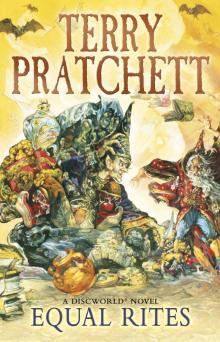 Equal Rites
Equal Rites A Hat Full of Sky
A Hat Full of Sky The Light Fantastic
The Light Fantastic Mrs Bradshaw's Handbook
Mrs Bradshaw's Handbook Wyrd Sisters
Wyrd Sisters Soul Music
Soul Music Small Gods
Small Gods Sourcery
Sourcery Reaper Man
Reaper Man Night Watch
Night Watch Lords and Ladies
Lords and Ladies The Fifth Elephant
The Fifth Elephant Monstrous Regiment
Monstrous Regiment The Truth
The Truth Witches Abroad
Witches Abroad Eric
Eric Going Postal
Going Postal Men at Arms
Men at Arms Jingo
Jingo The Amazing Maurice and His Educated Rodents
The Amazing Maurice and His Educated Rodents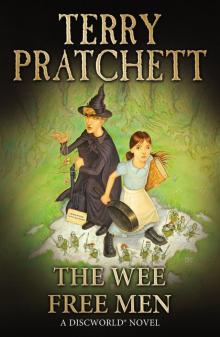 The Wee Free Men
The Wee Free Men Pyramids
Pyramids Wintersmith
Wintersmith Moving Pictures
Moving Pictures Carpe Jugulum
Carpe Jugulum Interesting Times
Interesting Times Maskerade
Maskerade Making Money
Making Money The Shepherd's Crown
The Shepherd's Crown Hogfather
Hogfather Troll Bridge
Troll Bridge The Last Continent
The Last Continent The Sea and Little Fishes
The Sea and Little Fishes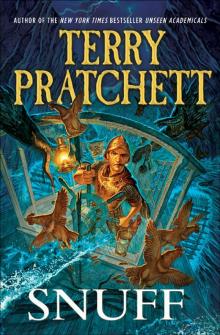 Snuff
Snuff Unseen Academicals
Unseen Academicals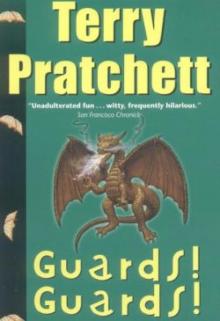 Guards! Guards! tds-8
Guards! Guards! tds-8 Jingo d-21
Jingo d-21 Turtle Recall: The Discworld Companion ... So Far
Turtle Recall: The Discworld Companion ... So Far The Fifth Elephant d-24
The Fifth Elephant d-24 Discworld 39 - Snuff
Discworld 39 - Snuff The Long War
The Long War Only You Can Save Mankind
Only You Can Save Mankind The Science of Discworld III - Darwin's Watch tsod-3
The Science of Discworld III - Darwin's Watch tsod-3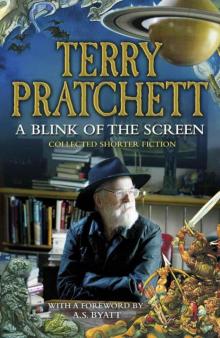 A Blink of the Screen: Collected Short Fiction
A Blink of the Screen: Collected Short Fiction Unseen Academicals d-37
Unseen Academicals d-37 Wings
Wings Making Money d-36
Making Money d-36 A Blink of the Screen
A Blink of the Screen Johnny and the Bomb
Johnny and the Bomb Dodger
Dodger Strata
Strata Discworld 02 - The Light Fantastic
Discworld 02 - The Light Fantastic The Folklore of Discworld
The Folklore of Discworld The Science of Discworld
The Science of Discworld The Unadulterated Cat
The Unadulterated Cat Raising Steam: (Discworld novel 40) (Discworld Novels)
Raising Steam: (Discworld novel 40) (Discworld Novels) The World of Poo
The World of Poo Discworld 05 - Sourcery
Discworld 05 - Sourcery The Witch's Vacuum Cleaner: And Other Stories
The Witch's Vacuum Cleaner: And Other Stories The Science of Discworld II - The Globe tsod-2
The Science of Discworld II - The Globe tsod-2 Small Gods: Discworld Novel, A
Small Gods: Discworld Novel, A Men at Arms tds-15
Men at Arms tds-15 Tama Princes of Mercury
Tama Princes of Mercury The Last Hero (the discworld series)
The Last Hero (the discworld series) The Long Utopia
The Long Utopia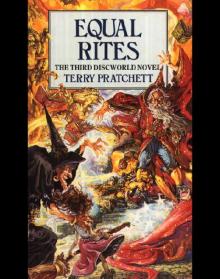 Discworld 03 - Equal Rites
Discworld 03 - Equal Rites Terry Pratchett - The Science of Discworld
Terry Pratchett - The Science of Discworld The Long Earth
The Long Earth The Carpet People
The Carpet People The Sea and Little Fishes (discworld)
The Sea and Little Fishes (discworld)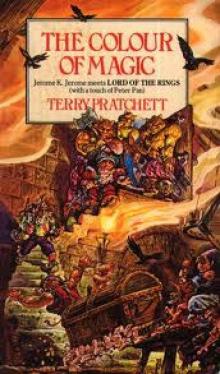 The Colour of Magic
The Colour of Magic Discworld 16 - Soul Music
Discworld 16 - Soul Music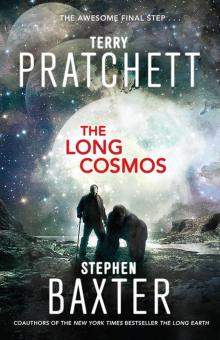 The Long Cosmos
The Long Cosmos The Dark Side of the Sun
The Dark Side of the Sun Monstrous Regiment tds-28
Monstrous Regiment tds-28 The Bromeliad 3 - Wings
The Bromeliad 3 - Wings Dragons at Crumbling Castle: And Other Stories
Dragons at Crumbling Castle: And Other Stories Night Watch tds-27
Night Watch tds-27 The Science of Discworld I tsod-1
The Science of Discworld I tsod-1 The Bromeliad 1 - Truckers
The Bromeliad 1 - Truckers The Science of Discworld Revised Edition
The Science of Discworld Revised Edition The Abominable Snowman
The Abominable Snowman Father Christmas’s Fake Beard
Father Christmas’s Fake Beard The Bromeliad Trilogy
The Bromeliad Trilogy A Slip of the Keyboard
A Slip of the Keyboard The Wee Free Men d(-2
The Wee Free Men d(-2 Johnny and the Dead
Johnny and the Dead Mrs Bradshaw's Handbook (Discworld Novels)
Mrs Bradshaw's Handbook (Discworld Novels) Truckers
Truckers The Amazing Maurice and His Educated Rodents d(-1
The Amazing Maurice and His Educated Rodents d(-1 Diggers
Diggers Thief of Time tds-26
Thief of Time tds-26 Science of Discworld III
Science of Discworld III Dragons at Crumbling Castle
Dragons at Crumbling Castle Nation
Nation Darwin's Watch
Darwin's Watch Interesting Times d-17
Interesting Times d-17 The Bromeliad 2 - Diggers
The Bromeliad 2 - Diggers The Science of Discworld II
The Science of Discworld II